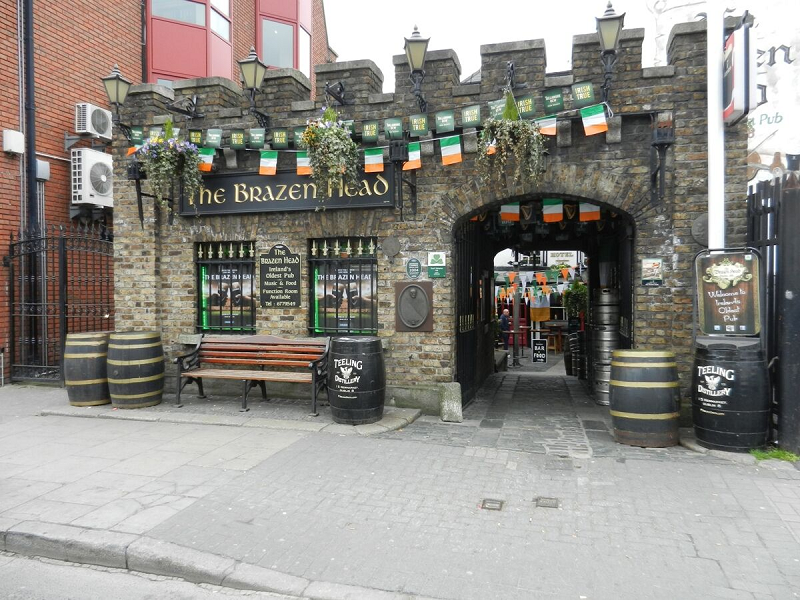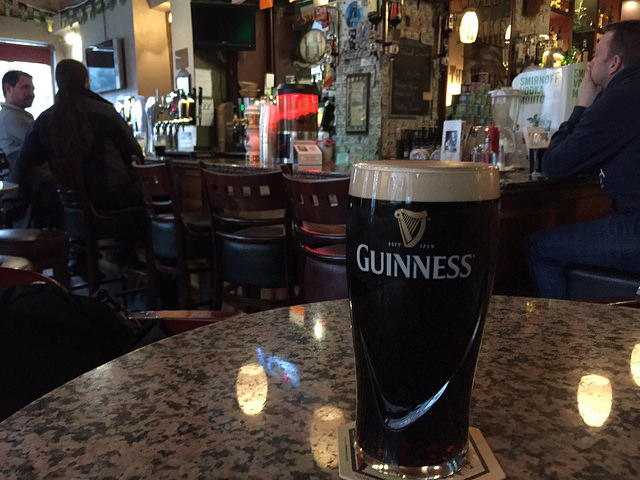The Lock-in and Other Irish Idiosyncrasies
[Full Disclosure. The following post came as a result of a visit I made to Dublin to the Guinness brewery. The folks at Diageo, Guinness’ parent company, paid for the trip and put me up while I was in Dublin. Guinness is also a sponsor of my personal blog, Beervana.]
Dublin, Ireland’s reputation for beer-drinking is exceeded by no other city’s, and matched by only a few (Munich and Prague spring to mind). The institution of the Irish pub is so powerful that replicas are found in every corner of the globe; shamrocks, stew and stout are an international fixture. But what is it like to actually drink in Dublin? Is the reputation deserved, or is this another case of disappointing hype?
An American who spends four scant days in Ireland ought to be very careful about what he thinks he knows. Especially one who only visits Dublin, a place where Americans maraud around in packs like drunken wild dogs. (I wouldn’t be surprised if more than one local has fed a gullible yank all the blarney he’s willing to believe.) On the other hand, I did manage to visit 14 pubs over the span, and along the way learned a few of this old drinking city’s habits. What follows are my early lessons in what indeed turned out be one of the best drinking cities in the world.
A Pub on Every Corner
In my own imagination, the home of Joyce, Beckett and Bono is a major city. The tactile reality is far different. Spread in two halves across the River Liffey, it is a typically low-slung European capital of four- and five-story buildings arranged in a tangle of ancient, narrow streets. (Though Dublin is a lot less ancient than you’d expect, dating back just hundreds, rather than thousands of years.) If you find yourself in the heart of the old town, the Temple Bar district, for example, you’re a short walk from St. Patrick’s Cathedral, the Guinness Storehouse, Jameson’s or Trinity College. And if you decided to take a stroll between any of these two points, you will pass pub after pub after pub.
And, as a rebuke to the Paddy O’Malley’s you find in the rest of the world, in Ireland, each pub is different. Some are spare as an American dive bar, shotgun spaces running 30 feet with a bar and a few tables. Others, like the sprawling Porterhouse Pub in Temple Bar, are so expansive they seem like interdimensional spaces folded together in fractals, each room connecting to another on into infinity. Some of the pubs are even hidden, like speakeasies. I met The Beer Nut for a pub crawl one evening, and he guided me to the pub connected to the Bull and Castle, a steakhouse. The pub, though, is accessed through an unmarked door on the street and leads to a darkened wood-paneled space that combines the coziness of a ship’s galley with the feel of a private gentleman’s club.

The Brazen Head in Dublin, Ireland. This is not the pub in which the author was locked-in. (Photo by Jeff Alworth)
The combination of a compact city and such a diversity of pubs encourages roaming. Four nights I went out drinking, and each time my guides and I would enjoy precisely one beer and then head off to the next pub. Drinking culture looks a lot like it does in the U.K. (for much of Ireland’s drinking history, it was the U.K.), but this seemed characteristic of a city with Dublin’s unique attributes. You don’t have one local, you have 37.
How to Drink in Dublin
I’m always on the lookout for unique quirks of a country’s drinking habits, and on day three, when I was out with a group of guys from the Guinness brewery, one was pointed out to me. We had just settled down for a pint at Arthur’s, near the brewery. (I believe it’s what Dubliners call a “boozer.”) Keith Dunne, one of the Guinness ambassadors, had taken his first drink and was still taking his first drink when someone gestured to him. When he placed the glass on the table, the top two or three fingers was missing. It is apparently characteristic of stout drinkers to begin with a massive first quaff and then proceed with normal sips through to the end of the pint.

A full pint of Guinness prior to that “massive first quaff.” (Photo by Jeff Alworth)
Since I was with Guinness folks that evening, I wondered if this was maybe a bit of invented lore for the visiting writer. The next evening, when I was again out with The Beer Nut, I asked about it. He considered the question and then confirmed that he’d seen his father drink this way, which he assumed was typical only of his father. “It’s probably true, then.” (The Beer Nut, one of the founders of Beoir, which promotes Irish craft beer, doesn’t spend a lot of time in Arthur’s drinking Guinness.)
While I was exploring possible old chestnuts, I asked about another. “If,” I asked the Beer Nut, “a bunch of Irish guys are about to drink their first beer, do they say ‘Sláinte’?” (It is always considered proper, among Americans drinking Murphy’s or Guinness in a Paddy O’Malley’s in the states, to toast each other in Irish.) “No, never,” he said. “We say ‘Cheers.’”
The Lock-in
Should you be very fortunate, you might chance upon a lock-in, as I did when I was out with the Guinness guys. We were in another boozer (since what I’m about to describe involves some low-level illegality, I’ll leave the name out of it), one of those 30-feet-and-a-bar places. There were a few characters at the bar, identified by our party as classical Irish archetypes. In my experience, they were pretty typical of bars in general, but either way, we were neither in a tourist bar nor a particularly fussy or hipsterish one.
It was pub five at the end of the evening, and in contrast to every other pub I visited, we were drinking multiple rounds. Domhnall Marnell, another Guinness ambassador, was fetching them at regular (and speedy) intervals, and I was practicing my first-drink gulp. It was one of those great evenings, when conversation ranges widely across topics. (The English writer Pete Brown had joined us, and at one point we went on a long, indulgent rant about how writers don’t get paid enough. You know, typical pub whingeing.)
About that time a curious thing happened. The publican went to the front of the narrow pub and drew the blinds over the two windows and locked the door. People observed it subtly around the table, with head nods and winks. What was happening is known as the lock-in, a rare and wondrous thing. On weekdays, Irish pubs are required by law to stop serving at 11:30. In rare cases, when the clientele looks safe enough to risk it, the publican might close the blinds and lock the door—but keep the pints flowing. From the beat cop’s street-level view, everything looks proper and closed down, but inside, the rants about paychecks can continue joyously on.
It wasn’t until I was back at the brewery the next day that I realized what a big deal it was. People kept coming up to me and saying, “I heard you got a lock-in!” Perhaps it happens more often than they let on, but maybe not so often with an American and an Englishman in attendance. Rare or not, it felt special. Special enough that I encourage everyone to see if you can get locked in if you’re ever in Ireland, too.
My advice: if you are American, try to blend in. Take big first gulps and don’t say “sláinte.” (Probably avoid lapsing into fake Irish brogue and mentioning leprechauns or the Queen of England, too.) Keep buying rounds. If you’ve done all those things and lived a good life, you might still be sitting there with good company well after 11:30.
Jeff Alworth is the author of the book, The Beer Bible (Workman, 2015). Follow him on Twitter or find him at his blog, Beervana.

Beer Bucket List!
I had something like a “lock-in” happen in a hotel bar in Limerick. We had arrived late Monday night from a flight from England and hurried to the hotel bar for a pint. The bartender indicated that the bar had closed but said that if we were guests of the hotel, they were obligated to stay open and serve us for as long as we were there. Poor guy didn’t understand we would stay until 1:45am :).
Dublin celebrated its Millenium in 1988.
It’s 1,000 years old.
Totally agree it’s an ancient city even before viking settlement.
I’m an American who lived in Ireland for 2 years and has visited often. The lock-in will occur in more ‘normal’ pubs. Not the trendy ones. Probably more common on weekdays, b/c on weekends people often continue on to clubs if they want to keep drinking.
The practice stands in stark contrast to my experience in England, when 11 pm rolled around and the staff were vacuuming under your chair and basically hustling you out. In Ireland they clean the back of the bar and gently move you closer to the the door.
The big thing you missed in this piece was drinking in rounds. “Pinting” is not an individual activity. If you go out with 4 people, you will be buying 4 pints. You can skip a round, but not your own round. So if you are going to be buying 4 pints, you might as well drink 4 pints. You also drink at the pace of the fastest drinker because when someone finishes their pint it is generally time for the next person to go get their round. This is a key piece of the true Irish beer drinking experience.
And yes, Dublin is an ancient city. Settled by Vikings. Name comes from Dubh Linn or Black Pool.
A thousand years is not ancient by European standards, and counts as hundreds of years old, not thousands.
How about all the new brewpubs? Did you visit any besides the Porterhouse?
Possibly pedantic, but AFAIK Porterhouse in Tempke Bar hasn’t been a working brewpub for a good few years, production moved out of town to a much bigger facility in Bray.
I love *good* pubs in UK & Ireland & have experienced lock-ins in both places. There are differences in atmosphere & customs in different parts of the countries of UK & Ireland. I’d say lock-ins are in my experience relatively rare in general, though the local social club near where I lived in the NW UK seemed to survive largely due to the extra revenue that came from the very regular & often very late unlicensed hours they kept every week.
It’s pot luck whether the lock-in you find yourself in is accompanied by fine beer & good company, but when it is, man it’s a real pleasure!
I did get to try a number of craft beers and visited Porterhouse and three Galway Bay pubs. Perhaps a future post…